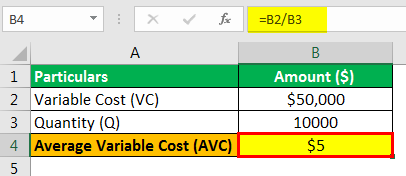

Increasing returns to the variable factors, which cause average costs to fall, followed by:.The average variable cost (AVC) curve will at first slope down from left to right, then reach a minimum point, and rise again.ĪVC is ‘U’ shaped because of the principle of variable Proportions, which explains the three phases of the curve: Average variable costsĪverage variable costs are found by dividing total fixed variable costs by output. The average fixed cost (AFC) curve will slope down continuously, from left to right. As fixed cost is divided by an increasing output, average fixed costs will continue to fall. Average fixed costsĪverage fixed costs are found by dividing total fixed costs by output. Its position reflects the amount of fixed costs, and its gradient reflects variable costs. The total cost (TC) curve is found by adding total fixed and total variable costs. The total variable cost (TVC) curve slopes up at an accelerating rate, reflecting the law of diminishing marginal returns. Given that total fixed costs (TFC) are constant as output increases, the curve is a horizontal line on the cost graph. Plotting this gives us Total Cost, Total Variable Cost, and Total Fixed Cost. Total variable costs (TVC) will increase as output increases. The total fixed costs, TFC, include premises, machinery and equipment needed to construct boats, and are £100,000, irrespective of how many boats are produced. The value signifies the average coal criticality position in a financial year which is derived by dividing total number ofĬritical days in terms of non availability of coal with number of stations remained critical.Consider the following hypothetical example of a boat building firm. It is derived from Billing Efficiency, Collection Efficiency, Average Billing RateĪnd weightage of feeder in terms of Input Energy. Total Amount Billed / Total Energy Billed Feeder Severity Index (FSI)įSI Indicates comparative severity of Impact of a feeder in a Discom in respect of AT&C losses. SAIFI is measured in units of no of interruptions per customer. NT and is the total number of customers served in all feeders of the town. of failure in the ith feeder and Ni is the number of customers in that feeder. Of Customers served) Assuming all customers connected with the feeder gets interrupted for each feeder failure,

SAIFI= (Total No Of customers interrupted)/(Total No. SAIDI is measured in units of time, in minutes or hours. Where Ui is the duration of interruption of the ith feeder and Ni is the number of customers in that feeder. SAIDI is the average outage duration for each customer served, and in 11 KV feeder system in the town level, SAIDI may be calculated as follows System Average Interruption Duration Index (SAIDI) is commonly used as a reliability indicator for electric power utilities. It is combination of energy loss (Technical loss + Theft + inefficiency in billing)& commercial loss (Default in payment + inefficiency in collection).


The concept of Aggregate Technical & Commercial losses provides a realistic picture of loss situation in the context it is measured. The aggregate technical and commercial losses shall be measured using formula mentioned below:- AT&C Losses = X 100 Collection efficiency to be capped at 100%. *The revenue collected shall exclude the arrears. Collection efficiency can be computed using formula provided below:- Collection Efficiency = Revenue Collected (In Rupees)* / Billed Amount (In Rupees) Thus utility is not able to recover entire amount billed by it, resulting in commercial losses.Ĭollection efficiency is an indicator of proportion of amount that has been collectedfrom consumers w.r.t. However, there are quite a few consumers who have tendency to default in their payments for various reasons. The billed amount is computed on the basis of tariff fixed by regulatory commission for applicable customer category. Billing Efficiency can be computed using formula provided below:- Billing Efficiency = Total Energy Billed to Consumers (kWh) / Total Energy Input (kWh) Collection EfficiencyĪll the consumers are billed on the basis of energy consumed by them which is obtained from meter reading and assessment of unmetered energy of consumers. Billing efficiency is an indicator of proportion of energy that has been billed (includes both metered and unmetered sales) to consumers w.r.t.


 0 kommentar(er)
0 kommentar(er)
